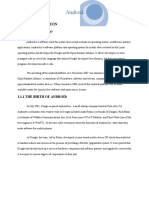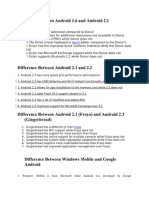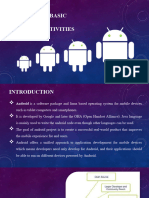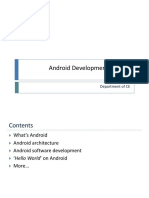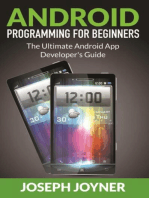Android Summary
Android Summary
Uploaded by
Madhava Ram ParanandiCopyright:
Available Formats
Android Summary
Android Summary
Uploaded by
Madhava Ram ParanandiCopyright
Available Formats
Share this document
Did you find this document useful?
Is this content inappropriate?
Copyright:
Available Formats
Android Summary
Android Summary
Uploaded by
Madhava Ram ParanandiCopyright:
Available Formats
Android is a software stack for mobile devices that includes an operating system, middleware and key applications.
Android is a software platform and operating system for mobile devices based on the Linux operating system and developed by Google and the Open Handset Alliance. It allows developers to write managed code in a Java-like language that utilizes Google-developed Java libraries, but does not support programs developed in native code. The unveiling of the Android platform on 5 November 2007 was announced with the founding of the Open Handset Alliance, a consortium of 34 hardware, software and telecom companies devoted to advancing open standards for mobile devices. When released in 2008, most of the Android platform will be made available under the Apache free-software and open-source license. .2. FEATURES 1.2.1. Application Framework It is used to write applications for Android. Unlike other embedded mobile environments, Android applications are all equal, for instance, an applications which come with the phone are no different than those that any developer writes.The framework is supported by numerous open source libraries such as openssl, SQLite and libc. It is also supported by the Android core libraries. From the point of security, the framework is based on UNIX file system permissions that assure applications have only those abilities that mobile phone owner gave them at install time. 1.2.2. Dalvik Virtual Machine It is extremely low-memory based virtual machine, which was designed especially for Android to run on embedded systems and work well in low power situations. It is also tuned to the CPU attributes. The Dalvik VM creates a special file format (.DEX) that is created through build time post processing. Conversion
between Java classes and .DEX format is done by included dx tool. 1.2.3. Integrated Browser Google made a right choice on choosing WebKit as open source web browser. They added a two pass layout and frame flattening. Two pass layout loads a page without waiting for blocking elements, such as external CSS or external JavaScript and after a while renders again with all resources downloaded to the device. Frame flattening converts founded frames into single one and loads into the browser. These features increase speed and usability browsing the internet via mobile phone. 1.2.4. Optimized Graphics As Android has 2D graphics library and 3D graphics based on OpenGL ES 1.0, possibly we will see great applications like Google Earth and spectacular games like Second Life, which come on Linux version. At this moment, the shooting legendary 3D game Doom was presented using Android on the mobile phone. 1.2.5. SQLite Extremely small (~500kb) relational database management system, which is integrated in Android. It is based on function calls and single file, where all definitions, tables and data are stored. This simple design is more than suitable for a platform such as Android. 1.2.6. Handset Layouts The platform is adaptable to both larger, VGA, 2D graphics library, 3D graphics library based on OpenGL ES 1.0 specifications, traditional smart phone layouts. An underlying 2D graphics engine is also included. Surface Manager manages access to the display subsystem and seamlessly composites 2D and 3D graphic layers from multiple applications
1.2.7. Data Storage SQLite is used for structured data storage .SQLite is a powerful and lightweight relational database engine available to all applications. 1.2.8. Connectivity Android supports a wide variety of connectivity technologies including GSM, CDMA, Bluetooth, EDGE, EVDO, 3G and Wi-Fi. 1.2.9. Messaging SMS, MMS, and XMPP are available forms of messaging including threaded text messaging. 1.2.10. Web Browser The web browser available in Android is based on the open-source WebKit application framework. It includes LibWebCore which is a modern web browser engine which powers both the Android browser and an embeddable web view. 1.2.11. Java Virtual Machine Software written in Java can be compiled into Dalvik bytecodes and executed in the Dalvik virtual machine, which is a specialized VM implementation designed for mobile device use, although not technically a standard Java Virtual Machine. 1.2.12. Media Support Android will support advanced audio/video/still media formats such as MPEG-4, H.264, MP3, and AAC, AMR, JPEG, PNG, GIF. 1.2.13. Additional Hardware Support Android is fully capable of utilizing video/still cameras, touchscreens, GPS, compasses, accelerometers, and accelerated 3D graphics. 1.2.14. Development Environment Includes a device emulator, tools for debugging, memory and performance profiling, a plugin for the Eclipse IDE. There are a number of hardware dependent features, for instance, a huge media and connections support, GPS, improved support for Camera and simply
GSM telephony. A great work was done for the developers to start work with Android using device emulator, tools for debugging and plugin for Eclipse IDE. 2. DETAILED DESCRIPTION OF THE TOPIC 2.1. OPERATION 2.1.1. Android Runtime Android includes a set of core libraries that provides most of the functionality available in the core libraries of the Java programming language.Every Android application runs in its own process, with its own instance of the Dalvik virtual machine. Dalvik has been written so that a device can run multiple VMs efficiently. The Dalvik VM executes files in the Dalvik Executable (.dex) format which is optimized for minimal memory footprint. The VM is register-based, and runs classes compiled by a Java language compiler that have been transformed into the .dex format by the included "dx" tool.The Dalvik VM relies on the Linux kernel for underlying functionality such as threading and low-level memory management. 2.1.2. Linux Kernel Android relies on Linux version 2.6 for core system services such as security, memory management, process management, network stack, and driver model. The kernel also acts as an abstraction layer between the hardware and the rest of the software stack. It helps to manage security, memory management, process management, network stack and other important issues. Therefore, the user should bring Linux in his mobile device as the main operating system and install all the drivers required in order to run it. Developers have full access to the same framework APIs used by the core applications. The application architecture is designed to simplify the reuse of components; any application can publish its capabilities and any other application may then make use of those capabilities (subject to security constraints enforced by
the framework). This same mechanism allows components to be replaced by the user.Underlying all applications is a set of services and systems. 2.2. ARCHITECTURE The following diagram shows the major components of the Android operating system. Each section is described in more detail below. Figure 2.1 : Architecture Of Android
You might also like
- Android Weather APP ReportDocument16 pagesAndroid Weather APP ReportHimanshu Bhatt100% (2)
- 8.D110S-5 Transmission SB4121E01Document58 pages8.D110S-5 Transmission SB4121E01francisco salcedo gonzalezNo ratings yet
- Richard Albert HundleyDocument11 pagesRichard Albert HundleyEunyoung Leah ParkNo ratings yet
- Aws Glue InformationDocument46 pagesAws Glue Information华希希No ratings yet
- Glycerinization of Foliages For Dry Flower Products MakingDocument6 pagesGlycerinization of Foliages For Dry Flower Products MakingAndreaNo ratings yet
- 1.1.1. Google Acquires Android IncDocument41 pages1.1.1. Google Acquires Android IncSubham SadraNo ratings yet
- Android: 1.1. The Birth of AndroidDocument24 pagesAndroid: 1.1. The Birth of AndroidKonda RaveendrakumarNo ratings yet
- 1.1 What Is ANDROID?Document24 pages1.1 What Is ANDROID?Geetha Reddy MNo ratings yet
- 1.1.1.google Acquires Android IncDocument26 pages1.1.1.google Acquires Android IncYogesh SoniNo ratings yet
- Android Seminar Report BodyDocument31 pagesAndroid Seminar Report BodyYedu100% (2)
- Attendroid Using Android: Google Acquires Android IncDocument31 pagesAttendroid Using Android: Google Acquires Android IncSai SandeepNo ratings yet
- Android Technology SeminarDocument31 pagesAndroid Technology SeminarArchie Srivastava0% (1)
- ABSTRACT: Android Is A Software Stack For Mobile Devices ThatDocument29 pagesABSTRACT: Android Is A Software Stack For Mobile Devices That12345mtp69% (13)
- Independent Study Seminar On Android: Made By: Siddharth 09ITMG1086CSEDocument26 pagesIndependent Study Seminar On Android: Made By: Siddharth 09ITMG1086CSEsetia_tarikNo ratings yet
- FulreprtDocument24 pagesFulreprtssomNo ratings yet
- Mini Project Report On Android Technology With Sample CodeDocument37 pagesMini Project Report On Android Technology With Sample CodeShashank89% (80)
- Android Seminar Report FinalDocument23 pagesAndroid Seminar Report FinalShivani GujralNo ratings yet
- Android OSDocument46 pagesAndroid OSShylock DasNo ratings yet
- Android: Next Generation Mobile ComputingDocument7 pagesAndroid: Next Generation Mobile ComputingSuhasini BadamNo ratings yet
- K.Ramesh V Semester Reg No.1709151Document15 pagesK.Ramesh V Semester Reg No.1709151Ramesh GowdNo ratings yet
- Difference Between Android 1.6 and Android 2.1: FroyoDocument5 pagesDifference Between Android 1.6 and Android 2.1: FroyoNguru PrasadNo ratings yet
- seminar-Anroid TechnologyDocument29 pagesseminar-Anroid TechnologyraginfotechdtgNo ratings yet
- Android Overview: Rao VandanaDocument50 pagesAndroid Overview: Rao Vandanaajaj ansariNo ratings yet
- Android TurorialDocument216 pagesAndroid TurorialSrinivas MahantiNo ratings yet
- Android Architecture: Giteswar Goswami 19cs801014Document8 pagesAndroid Architecture: Giteswar Goswami 19cs801014Giteswar GoswamiNo ratings yet
- Android TurorialDocument179 pagesAndroid TurorialSrinivas MahantiNo ratings yet
- Visvesraya Technological University BELGAUM-590018.: Department of Computer Science Android OSDocument12 pagesVisvesraya Technological University BELGAUM-590018.: Department of Computer Science Android OSSachin GowdaNo ratings yet
- MAD Lab DocumentDocument32 pagesMAD Lab DocumentDhyan MohanNo ratings yet
- Android Application Development Training Tutorial: For More Info VisitDocument5 pagesAndroid Application Development Training Tutorial: For More Info VisitzybotechsolutionsNo ratings yet
- Android Operating SystemDocument18 pagesAndroid Operating SystemManu JhaNo ratings yet
- QB Solution PT-1 MADDocument31 pagesQB Solution PT-1 MADAryan BuchakeNo ratings yet
- Submitted By,: Vishnu M.S No: 42 S7 Cs CealDocument14 pagesSubmitted By,: Vishnu M.S No: 42 S7 Cs CealFazal SayyedNo ratings yet
- Android: Application Framework Dalvik Virtual Machine Integrated BrowserDocument41 pagesAndroid: Application Framework Dalvik Virtual Machine Integrated Browseradithyaram011549No ratings yet
- Android Is A LinuxDocument5 pagesAndroid Is A Linuxvivaan2No ratings yet
- Umer Shahzad: Android Development Training JDKDocument23 pagesUmer Shahzad: Android Development Training JDKAamir ikramNo ratings yet
- What Is Android?: Open Handset AllianceDocument8 pagesWhat Is Android?: Open Handset AlliancePonnam ThulasiramNo ratings yet
- AndroidDocument16 pagesAndroidShruthi ReddyNo ratings yet
- An Evolution of Android Operating System and Its: K.Chinetha, J.Daphney Joann, A.ShaliniDocument4 pagesAn Evolution of Android Operating System and Its: K.Chinetha, J.Daphney Joann, A.ShalinisaimanobhiramNo ratings yet
- Andriod OSDocument19 pagesAndriod OSعلي محمود علي عاصيNo ratings yet
- Android BasicDocument28 pagesAndroid BasicSri GayuNo ratings yet
- Android ArchitectureDocument6 pagesAndroid ArchitectureBhaskar Rao PNo ratings yet
- An Introduction To: AndroidDocument14 pagesAn Introduction To: AndroidAbhiram HollaNo ratings yet
- Unit 2Document15 pagesUnit 2Chess BlogsNo ratings yet
- Documentatuin 12 ADocument59 pagesDocumentatuin 12 AMr AneeshNo ratings yet
- Android Development TutorialDocument50 pagesAndroid Development TutorialShailesh SahuNo ratings yet
- What Is Android?Document13 pagesWhat Is Android?Bharat HazarikaNo ratings yet
- Unit-5 E-HealthDocument42 pagesUnit-5 E-HealthsuhasperumallaNo ratings yet
- Mobile Operating System: BY S.Siddharth 07P71AO497Document26 pagesMobile Operating System: BY S.Siddharth 07P71AO497Siddharth SheshadriNo ratings yet
- Changed 12Document63 pagesChanged 12rush2arthiNo ratings yet
- Android Development TutorialDocument50 pagesAndroid Development TutorialSachin PatelNo ratings yet
- Khushi Beyond SyllabusDocument9 pagesKhushi Beyond SyllabusRythmn MagnaniNo ratings yet
- Android ArchitectureDocument3 pagesAndroid ArchitectureRajesh KannaNo ratings yet
- Mobile Application Development NotesDocument133 pagesMobile Application Development Notessephule1997No ratings yet
- OSY-Microproject V VDocument20 pagesOSY-Microproject V VComputer ActivityNo ratings yet
- What Is Android?: Open Handset AllianceDocument8 pagesWhat Is Android?: Open Handset AllianceSreenivas Reddy BNo ratings yet
- Introduction of AndroidDocument9 pagesIntroduction of AndroidVaibhav HatodeNo ratings yet
- Android SeminarDocument14 pagesAndroid Seminartechveer2015No ratings yet
- Unit No.1Document23 pagesUnit No.1Atharv KadamNo ratings yet
- Android Report - ابانوب عماد فارسDocument22 pagesAndroid Report - ابانوب عماد فارسAbanob EmadNo ratings yet
- Computer Science & Engg - FileDocument39 pagesComputer Science & Engg - FilePushpendra KumarNo ratings yet
- Mad UtDocument5 pagesMad UtAakash ChaudhariNo ratings yet
- Android Architecture: Linux KernelDocument2 pagesAndroid Architecture: Linux KernelBhanu PratapNo ratings yet
- AndroidDocument9 pagesAndroidSowjanya KotaNo ratings yet
- Android Programming For Beginners: The Ultimate Android App Developer's GuideFrom EverandAndroid Programming For Beginners: The Ultimate Android App Developer's GuideNo ratings yet
- Welding-Process 222Document63 pagesWelding-Process 222Jasm OmranNo ratings yet
- Pharmaceutical Marketing Cialis CaseDocument2 pagesPharmaceutical Marketing Cialis CaseTeddy BuriéNo ratings yet
- Proof of GOD ExistenceDocument8 pagesProof of GOD Existenceعلیزہ علیNo ratings yet
- English Language Project - Oindri MandalDocument15 pagesEnglish Language Project - Oindri MandalOindri MandalNo ratings yet
- ADR Construction Arbitration CaseDocument8 pagesADR Construction Arbitration CaseAilene Heramil PonioNo ratings yet
- Biography of Daniel DefoeDocument2 pagesBiography of Daniel DefoeChrisNo ratings yet
- Risperidone Tablets 2mg & 4mg - Taj Pharma Leaflet Patient Medication InformationDocument3 pagesRisperidone Tablets 2mg & 4mg - Taj Pharma Leaflet Patient Medication InformationTAJ PHARMA — A Health Care ProviderNo ratings yet
- Gender Roles in DisneyDocument11 pagesGender Roles in DisneyalexangieNo ratings yet
- If His Constent Is Not Induced by Misrepresntation: OtherDocument19 pagesIf His Constent Is Not Induced by Misrepresntation: OtherAnshum KathuriaNo ratings yet
- Practical Lab # 6. Measurement of Drag and Lift of An Aerofoil at Different Angles of AttackDocument7 pagesPractical Lab # 6. Measurement of Drag and Lift of An Aerofoil at Different Angles of Attackamanuelfitsum589No ratings yet
- Akantosis NigrikanDocument18 pagesAkantosis Nigrikanm.delfi ikhwandaNo ratings yet
- Hortatory TextDocument2 pagesHortatory TextDaffa MuhammadNo ratings yet
- Karnataka Regulation of Stone Crushers Act, 2011Document17 pagesKarnataka Regulation of Stone Crushers Act, 2011Latest Laws TeamNo ratings yet
- Pick and Place Robot Using Arduino Using BluetoothDocument39 pagesPick and Place Robot Using Arduino Using BluetoothVishal Guleria71% (7)
- Margie Goldschmidt 2007 Interview Re: Pedophilia, Child Sexual Abuse by Her Husband Mayor/Governor GoldschmidtDocument68 pagesMargie Goldschmidt 2007 Interview Re: Pedophilia, Child Sexual Abuse by Her Husband Mayor/Governor Goldschmidtmary engNo ratings yet
- Lecture 2 SQLDocument50 pagesLecture 2 SQLPeter L. MontezNo ratings yet
- Low-Fat Vs Low-CarbDocument8 pagesLow-Fat Vs Low-CarbTrismegisteNo ratings yet
- Natural Lighting Study in Residential Buildings According To Local Building Codes in EgyptDocument10 pagesNatural Lighting Study in Residential Buildings According To Local Building Codes in Egyptkako2006No ratings yet
- TVL ResumeDocument1 pageTVL ResumeAiron JamesNo ratings yet
- Myths and Facts About InfertilityDocument6 pagesMyths and Facts About Infertilityannu rawatNo ratings yet
- Cook PDFDocument43 pagesCook PDFGouri BhosaleNo ratings yet
- Technical Bulletin: SECTION: 204-06Document12 pagesTechnical Bulletin: SECTION: 204-06christian jad ankerNo ratings yet
- 21st Century LiteratureDocument3 pages21st Century LiteratureMaribel MalaguenoNo ratings yet
- Understanding Metal Stamping - Design To Prototyping To ProductionDocument11 pagesUnderstanding Metal Stamping - Design To Prototyping To ProductionRAKHEE RICHHARIA100% (2)
- LLB Fundamentals of Criminal Law Notes LLB Fundamentals of Criminal Law NotesDocument127 pagesLLB Fundamentals of Criminal Law Notes LLB Fundamentals of Criminal Law NotesBharggav Shorthand Classes100% (1)
- 34 ArticleText 73 1 10 20191123Document7 pages34 ArticleText 73 1 10 20191123Heart BrokenNo ratings yet







